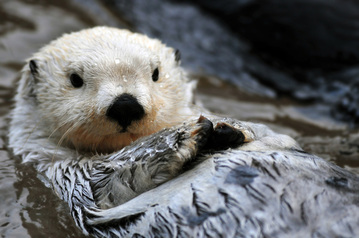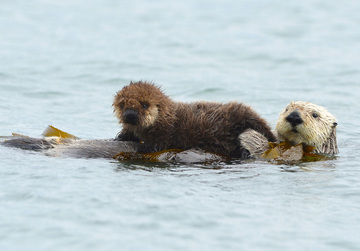
sea otter blogFrom:Dianne Walter <
If you have ever visited the Pacific Ocean along the Central Coast of California, perhaps near Monterey or Morro Bay, you might have been one of the lucky few who spotted a wonderful furry animal floating on his (or her) back, peacefully riding up and down the swells, usually eating a crab or a clam, using its tummy as a table. That, dear friends, was a Southern or California sea otter. They are very rare, only about 3,000 living along the California coast today. At one time, they were much more plentiful but over the last few hundred years, they were hunted nearly to extinction for their lovely soft fur. It was thought that they were extinct until a small group of about fifty otters was discovered in a hidden cove. They are now protected, listed as a “Threatened” species under the Federal Endangered Species Act. It is illegal to harm them or disturb them in any way.
Sea otters may look small, floating and playing in the waves but they are actually pretty big. The males can reach sixty pounds and they have sharp teeth. They eat all sorts of seafood: clams, crabs, squid, but one of their favorite foods is sea urchins. This is important because sea urchins love to eat the “hold fast” or root of giant kelp. Giant kelp grow in great forests often over 100 feet tall in the ocean along the coast. Kelp forests provide habitat for hundreds of different fish and other sea life. Kelp forests also damp or reduce the impact of waves washing away the shoreline. The one weakness of the Giant Kelp is that it grows from that one root attached to the sea floor and sea urchins can just nibble right through it. Once the kelp loses its root, it is washed ashore where it dies in smelly piles full of flies. Without the sea otter to control the urchins, the kelp forests would disappear along with many other sea animals that live in the safety of their waving leaves.
 Mother sea otter with her baby riding on her tummy
Mother sea otter with her baby riding on her tummy Another serious danger threatening the sea otters is oil. Oil is spilled into the ocean from ships and offshore wells. If even a small amount of oil gets on an otter’s fur, it can kill it. Otters must keep their fur clean in order to stay warm. They don’t have a layer of blubber like a whale or a seal. Their fur is amazingly thick and traps air next to their skin, keeping them cozy and warm even though they live in the frigid Pacific Ocean. But if their fur gets contaminated with oil, they can’t clean it off and they will die of the cold.
There are a number of organizations working hard to protect and save sea otters. Here are links to some of them where you can find out more about sea otters and how to help save them.
www.montereybayaquarium.org
www.marinemammalcenter.org
www.seaotters.org/
www.oceanconservancy.org
http://www.fws.gov/ENDANGERED/laws-policies/index.html
 RSS Feed
RSS Feed